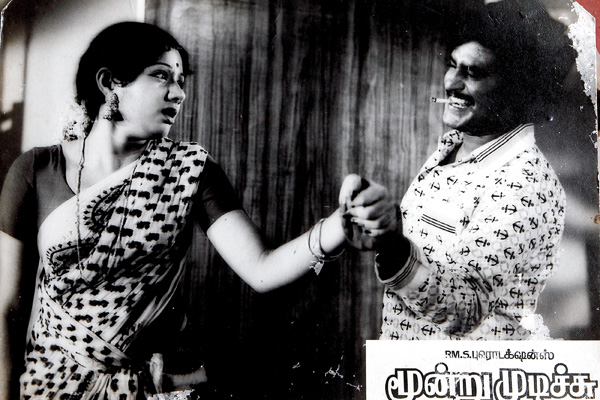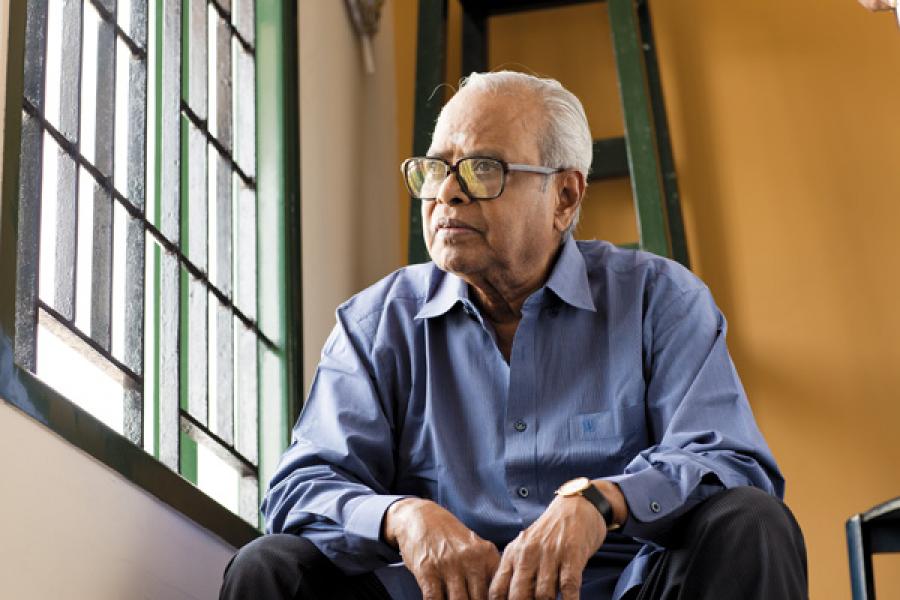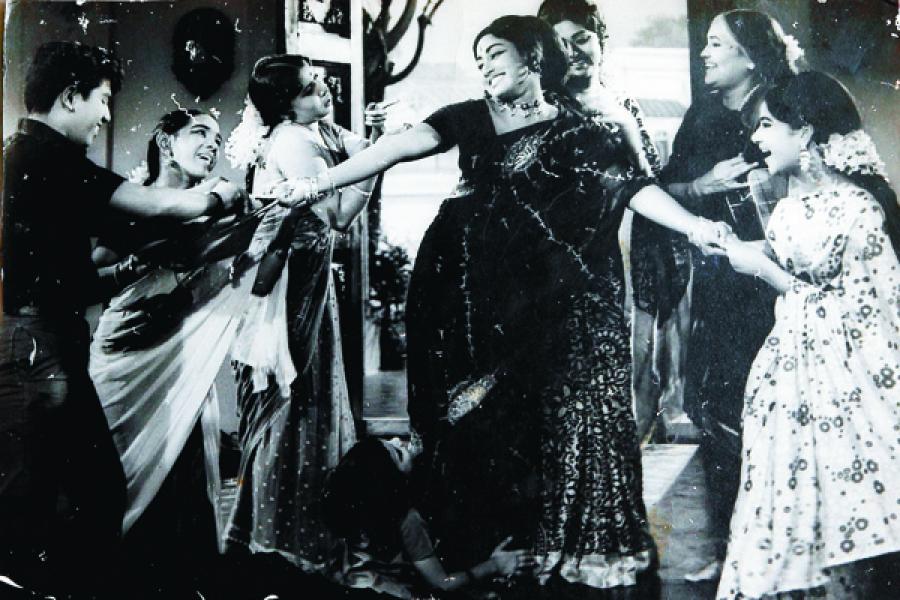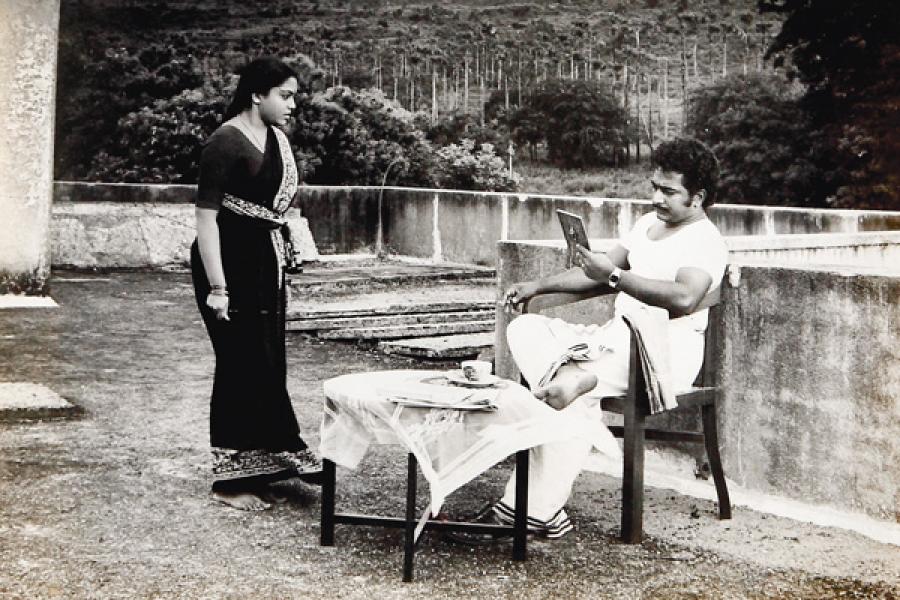
K. Balachander: The Middle-Class Maestro
Five decades of adamant, uncompromising moviemaking and K. Balachander is still in no mood to draw the curtain
When he appeared on screen for the first time, they weren’t immediately mesmerised.
He: A lanky, dark-skinned actor playing a character twice his real age, the abusive (and later, cancer-stricken) husband of the female protagonist, in the 1975 Tamil film Aboorva Raagangal (Rare Melodies). Unhandsome, tentative, he appeared late and only fleetingly in a movie dominated by stars such as Kamal Hassan and Sri Vidya.
They: The Tamil movie fans of the time — used to the colossal magnificence of Sivaji Ganesan and the charismatic dynamism of M.G. Ramachandran — couldn’t quite place the new actor. Neither could they find any remarkable feature in him but for his melancholic face and exotically accented Tamil.
But then, magic happened.
As the weeks rolled by, and the movie struck pay-dirt in the box office, the cinema-obsessed Tamil public lost its heart to Shivajirao Gaekwad a.k.a. Rajinikanth. Suddenly, they found a certain magnetism in his eyes, an effortless manner in his gait, a sparkle in his voice. They spoke ceaselessly of his cameo rather than of the marquee names in that movie. Here is a star like no other, they said. A bundle of Sivaji, MGR and some more.
One man wasn’t a bit surprised by all this brouhaha. After all, it was his script that was playing out.
Kailasam Balachander (KB), who would go on to become India’s most prolific filmmaker and direct more than 100 movies, had bet big on Rajinikanth. “In my forthcoming movie, I am introducing a young man who has fire in his eyes,” he had written just weeks earlier in the film magazine Pesum Padam. “Just mark my words. He will go on to become a phenomenon.”
36 years later, we call up to congratulate KB on winning the highest honour in Indian cinema, the Dadasaheb Phalke award.
“Naan sonna maadhirye nadandhadha, illaya?” Balachander asks us, the characteristic effervescence in his voice intact. “Hasn’t it happened exactly the way I had predicted?”
Balachander has deeply influenced and transformed Tamil cinema over a period of 47 years.
With people, he has been a veritable Midas having discovered more than 100 stars and technicians. The roll call of the “KB School” reads like a Who’s Who of South Indian cinema: Besides Rajinikanth, his protégés include such icons as Kamal Hassan, Sridevi, Chiranjeevi, A.R. Rahman, Jayaprada and Ramesh Aravind, not to speak of the countless directors and scriptwriters he inspired.
And it’s not like he then hitched his wagon to their stars: He spent a lifetime shunning the big names and making movies with newcomers nobody had heard of. Balachander never even directed MGR, who had brought him to the world of films in the first place, and he made just one movie with Sivaji. In fact, he stopped making movies with Rajini or Kamal once they became big stars (well, mostly).
As if that wasn’t enough, KB pushed his luck by choosing themes that were not just far ahead of their time but considered downright scandalous in their day. His movies often operated on the edge of social tolerance on subjects such as sexual freedom, unconventional love and women’s rights.
Those were the days when movies depended — as they do now — on upright heroes smooching behind tree trunks with otherwise chaste heroines and upholding mother’s love. So there was no reason why Balachander should survive in the superficial cesspool of formulaic Tamil moviedom even for a month.
As it turned out, he has thrived there for nearly five decades.
By any reckoning, Balachander was an outsider. By 1949, when this god-fearing Brahmin boy completed his B.Sc (Zoology) from Annamalai University, the raucous, anti-Brahminical Dravidian movement had begun making inroads into the Tamil film industry. In the ensuing years, Dravidian stalwarts such as C.N. Annadurai, M. Karunanidhi, Sivaji Ganesan and MGR came to dominate the industry either as writers or actors.
Balachander, meanwhile, settled into a comfortable life as a government servant. He got married in 1956 and the couple had two sons and a daughter. In time, he rose to be a superintendent at the Accountant General’s Office in Madras. This is the office that today unearths ugly affairs such as the 2G spectrum scandal but in those days, the job was much less exciting, given the general honesty of the ruling class. So, to while away time, a bunch of officers at the AG’s office came together to form an amateur theatre group. Given his flair for writing, Balachander became the playwright.
And what did these English-educated middle-class friends with an amateur drama troupe do? They wrote and acted their plays in English. Their tiny audience, largely made up of fellow officers of the Government of India, were just as comfortable in the Queen’s language as they were.
When a new accountant general took over in 1963, there was a felicitation and Balachander wrote a play for the occasion, titled Major Chandrakanth. It was about a blind, retired military officer giving refuge to the murderer of his son. Balachander didn’t know at that time, but the play would be later made into a movie in three languages (Major Chandrakanth in Tamil, Sukhadukhaalu in Telugu and Oonche Log in Hindi).
For the moment, among the gentle paper-pushing folk of the AG’s office, the play was an instant hit. One thing led to another and soon, friends were nudging KB to stage his plays for the general public. Since English wasn’t exactly the language of the arts in Madras, Balachander translated the plays into Tamil and took them to the ‘Sabha’ halls across the city.
Matinee idol MGR was one of KB’s early fans. “I later learnt that he had followed all my plays,” says KB. MGR particularly liked Server Sundaram, about a poor waiter who finds success as a film star but gives it all up in the end. In 1964, MGR was searching for a scriptwriter for his forthcoming movie Deivath Thai (Divine Mother), and decided to give KB a chance.
“It was sheer accident that MGR gave me the break and I grabbed it,” says Balachander. But his joy soon faded. Writing a script for a major star wasn’t easy. KB had to adapt it in MGR’s larger-than-life image. It was constricting his creativity.
He thought long and hard about his objectives. “That day, I decided I will never associate myself with great stars. I wanted my own views, my own
perspective to come out in the movies.”
Within one year, he established himself as a successful scriptwriter and took most of his plays to the big screen. He retained his job at the AG’s office, though, and mostly worked on his scripts while on leave. “The superintendent job made sure my bread and butter were ensured. And that made it possible for me to search for my own identity in films and not play second fiddle to heroes and heroines.”
But taking off from work was becoming increasingly difficult. At the start of 1965, Balachander had to make a choice between a highly unpredictable movie career and a secure government job. With a family to care for, he couldn’t afford to make a wrong move.
The legendary AVM Studios came to his rescue. AVM’s Meiyappa Chettiar not only counselled him to take the plunge into movies but also booked him as director for three movies. “Before I knew, I became very busy. All my scripts except one became films.”
In the 1960s, most Tamil films portrayed people as being either rich or poor. The conflict between the two classes often formed the backdrop for the plot. There wasn’t much of a concept of the middle class. It was KB who first made films about the middle class, for the middle class. Thus, his movies stood out from the usual fare and quickly acquired a loyal following among the urban, educated gentry.
But there was one problem. It took years for KB to think cinema. Throughout the 1960s, he was still thinking drama. “While writing a script,” he recalls, “I was restricting myself to a few characters and one set. If you watch my early movies, you will find them happening mostly in one place.”
“He started by basically photographing his dramas rather than creating movies,” says film historian Theodore Baskaran, who at 71 is just 10 years younger than Balachander and has been researching cinema for as long as KB has been making it. “But even with that, he extended the frontiers of Tamil cinema by not relying on stars and creating a space for newcomers.”
But Balachander soon ran out of plays to convert to screen tales. By 1970, he was seriously in search of new themes that would stand out from the heroic tall tales that others were making by the dozen. “I had an insatiable urge to be different from others; to take the path not travelled by others,” he says.
Before he began exploiting the camera fully, KB chose to make his scripts more radical. One of his earliest efforts was Arangetram (The Debut) in 1973, which he remade as Aaina in Hindi four years later. It tells the story of a young woman who supports her conservative, but extremely poor Brahmin family. The crushing burden of poverty pushes her to prostitution. The family, though happy with the money, ditches her when the truth comes out.

In the years to follow, KB would make more films that dealt with taboo subjects even as his scenes started to breathe fresh air. In Avargal (Them), he told the story of a woman’s life that moves from divorce to marriage to love with three different men. Balachander used the then state-of-the-art technique of superimposition, in a song shot along the beaches of Madras, to signal his new passion for outdoor shooting. To this day, the song stands as a symbol of the free expression of a self-willed woman.
Balachander’s success revealed to moviemakers that the public was open to new themes and faces. Baskaran says, “It was this space created by him that opened the gates for great directors such as Bharathiraja, Balu Mahendra, Bhagyaraj and Mahendran.”
This effectively ended the free run that Sivaji and MGR had had for decades. Tamil cinema moved to a more realistic, less melodramatic level. KB focussed on urban, middle-class themes. Bharathiraja made us fall in love with the beauty of village life. Balu Mahendra wrote poetry on camera. Mahendran thrived on subtlety and bridged the distance between art and box office. With new stars such as Kamal and Rajini, and a rustic musician called Ilayaraja, coming into play, Tamil cinema was never the same again.
Balachander is obsessed with women.
Actress Suhasini, wife of director Mani Ratnam, once said she enjoyed acting in Balachander’s movies because he showed his women characters as strong, independent and intelligent beings. He never used them as spice to the main meal dished out by the hero. “At that time, I looked around and realised nobody was looking at the travails of women. I decided to do so.”
When wronged, KB’s women don’t wail but take subtle revenge. In Moondru Mudichu (Three Knots, 1976), Sridevi is hounded by a villainous Rajinikanth after her lover Kamal Hassan dies. Cornered by circumstances, she is almost forced to agree to a marriage with him. But in a last minute twist, Sridevi marries Rajini’s father and becomes his stepmother.
In Nizhal Nijamaagiradhu (Illusion Becomes Reality), a reformed playboy apologises and proposes marriage to the woman he raped. But she rejects him and goes to live with the man after her own heart.
The year 1978 saw the release of the most enduring love story ever to have flowed from KB’s pen. And it was not even in Tamil. It was called Maro Charitra in Telugu; In Hindi, it became Ek Duuje Ke Liye.
The whole nation was gripped by the powerful tragedy for a year after its release. It told the story of a Tamil boy falling in love with er… who doesn’t know the story of Ek Duuje Ke Liye? (Just in case you don’t, it was about the love between a Tamil boy and a North Indian girl, ripped apart by the enmity of their parents, a long separation and the wily ways of a parochial society.)
The Telugu movie ran for a full year. Three years later, the Hindi version swept away all box office records, and won a national award for playback singer S.P. Balasubramaniam and two Filmfare awards. Critical acclaim was almost universal. Today, it is seen as a milestone in Indian cinema. (More than two decades later, American singer Britney Spears would use a small tune from the memorable song Tere Mere Beech Mein in her song Toxic.)
Through the 1980s, KB continued to push offbeat themes to an audience increasingly hooked to the masala dished out by his finds Kamal and Rajini. He was nimble enough to understand their tastes but never compromised on his originality. As a result, from Achamillai, Achamillai (No Fear) in 1984 to Pudhu, Pudhu Arthangal (New Interpretations) in 1989, the public had to make allowances for the KB style of storytelling: He had made it clear that he would not be the one to adjust.
When middle-class women, the bulk of KB’s fan following, moved en masse to television in the 1990s, he moved with them too. He pioneered the teleserial era in Tamil, with Rail Sneham (Rail Friendship) that created waves on Doordarshan and was re-telecast on Sun TV years later by popular demand. Since then, he has emerged as the king of soap opera, telling stories of family intrigue that no longer have a place in mainstream cinema.
At 81, KB is not yet considering retirement. He remains active and attends events. He dresses up and never forgets to tuck in his shirt. He often sports a jacket too. Perhaps there is in him a bit of the Accountant General he never became.
We ask him if he has the energy to make one more movie. Yes, of course, he says. A plot is already simmering in his head. But the quintessential middle-class storyteller isn’t about to splurge money. “Look at today’s budgets. People make movies for [Rs.] 15, 20 crore. I won’t be spending so much.”
Kamal once said his ambition was to direct a movie starring K. Balachander. KB must think twice before agreeing to the role reversal: The kind of grind that KB puts his actors through — and which Kamal and Rajini experienced in their early days — is not easy to endure. Maybe that is the idea!
Recently, after the release of the blockbuster Robot, Rajinikanth met Balachander at a public event. KB used the opportunity to do an impromptu interview with the superstar. He told him that they must work together again.
A surprised Rajini nodded, perhaps wondering what was coming next.
KB calmly told him that since he wouldn’t make movies to fit the inescapable Rajinikanth formula, it was up to the actor to make the adjustment. His first ever play, Major Chandrakanth, could be staged again. “Will you act as the Major?” Rajinikanth put aside all his concerns about image and call sheets and such and immediately said yes.
Mind it! KB is Rajini’s boss.
(This story appears in the 15 July, 2011 issue of Forbes India. To visit our Archives, click here.)
-
 Aditya
AdityaKb sir is truly a legend nd trendsetter..as righty said in this article.f he hadnt started d realistic trend many directors like even mani ratnam could not have come and told realistic stories on celluloid. Adn moreover,tamil cinema would have followed simply brainless masala films of bollywood. kb sir gave true identity to all the flms he made..his flms were a real surprise package for audiences..just wish he makes 1 more good movie for all of us..by the grace of god.
on Apr 21, 2012 -
 Krishnan 27 March 2012
Krishnan 27 March 2012Who can be the best director? Ascor says: While watching the movie the director (direction) should not come to our mind. All the charaters should not reflect the action of the director. Watch closely balachander`s movie. Fans always appreciate the direction of director and even in characters of the artistes. Upto AvaL ORU THODARKATHAI Balachander got appreciation. After Apporva Ragangal the director lost his credit. (Remake of 40 carats).. almost most of movies were all remake of other language movies. It was published in BOMMAI. Though the direction seems enjoyable the climax of the movie always confusing which is more important. Luckily the new comers introduced by this director almost got succeeded in their film career with other directors.
on Mar 27, 2012 -
 Akshay Gupta
Akshay GuptaI remember him for one of his serials shown on sony channel " Chhoti Si Asha". The very first TV shows we as a family used to watch together and taught me meaning of life. I really miss that complete show and pity the fact that no print is available to re - watch the serial. If a DVD can be provided of the same, I will be really greatful. Also just want to see the small girl recite the complete title track: " Seene mein hai dil ye chota sa.... Dil mein hoti choti si asha.... Chanda aur Sitare ismein..Dharti k najare ismein.. Gehra ha ye sagar ki jaisa.....".
on Feb 6, 2012

















